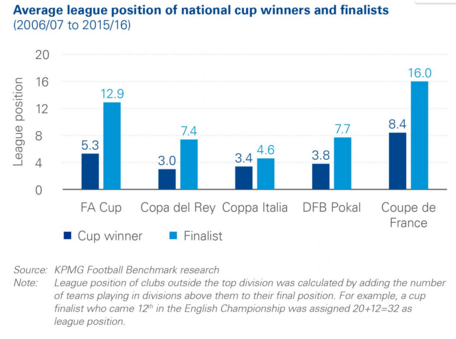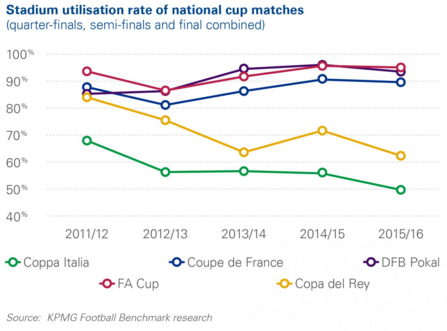January 12 – With the English FA Cup having played its first weekend with the Premier League teams in the competition, and Spain’s Copa del Rey being marked by a comeback performance by Barcelona and Messi brilliance to get them though to the quarter finals, the question of whether Cup competitions are a distraction or an opportunity is being asked across Europe.
A piece of analysis by KPMG’s Football Benchmark team looks at the recent history of cup competition in Europe’s Big 5 nations and broadly finds that the competitions have held their value – whatever managers might say and however many players they rest – and that the fans will support them, especially the latter stages.
The commercial impact of Cup competitions across the leagues is clearly still significant for clubs, providing more fixtures and extra prize money. For the big clubs the question is whether this impacts on their progress in other more highly prized competitions. For the clubs from the lower leagues it is the opportunity for a big pay day against higher league and big club opposition. Those pay days can save a club’s financial season.
Football Benchmark points out that the different structure of the cup competitions influences which clubs consistently make it through to the final rounds.
Spain’s Copa del Rey plays all ties between the round of 32 and semi- finals over two legs, weighting the winning teams towards those at the top of the league. In comparison single match knock-out rounds increase the chances of a giant-killing performance – regular occurrences in the FA Cup and the key appeal of the early rounds.
But it is the level of fan interest that really marks out whether the cup competitions hold positions of value.
Andrea Sartori, KPMG’s Global Head of Sports, said: “While spectator interest is lower than the appetite for league football, part of the appeal is the possibility of the unexpected, notably smaller clubs outperforming and achieving surprise results. The analysis of recent finalists seems to confirm this is more likely within a structure that allows for “one-off” results rather than programmes of multiple games in which the stronger teams will inevitably flourish.”
The report finds that the FA Cup, the DFB Pokal and the Coupe de France all performed at a consistently high level in terms of average utilisation (Football Benchmark’s term for the percentage capacity of the stadium filled), “reaching a rate of over 80% in all five analysed seasons and showing a strong public interest in cup ties. In the case of France, this positive result was aided by a significant number of clubs from outside Ligue 1 advancing to the latter stages of the competition as for these ties a sell-out is almost guaranteed.”
In contrast all five seasons the Coppa Italia, where the last eight teams left in the cup are usually among the best in Italy, finished last in the ranking by utilisation and in 2015/16 the average utilisation from the quarter-finals stood at 50%, but still only slightly lower than the most recent Serie A season (54.5%).
See the full report at https://www.footballbenchmark.com/domestic_cups
Contact the writer of this story at moc.l1713600863labto1713600863ofdlr1713600863owedi1713600863sni@n1713600863osloh1713600863cin.l1713600863uap1713600863



